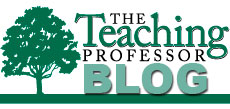Every teacher has strengths and weaknesses. Have you ever tried to list yours? Doing so is a worthwhile activity. I’d recommend doing it in private with a favorite libation—only one, because there is a need to be thoughtful and honest.
I’m still thinking about mid-career issues, and I’m wondering whether by the time we reach the middle of our careers, we can’t confront our weaknesses with a bit more maturity.
 I’ve come to believe that some weaknesses simply must be accepted. That doesn’t mean we no longer care about them. It doesn’t mean we stop trying to improve them, but it does mean they’re never going to be our strengths. That’s where I am in thinking about my organizational skills. I do fine on paper. I can outline. I understand hierarchy, flow, and the need for transitions, but when I present, it’s not always well organized. I get going, and one thing leads to the next: a new idea pops up in my mind, somebody asks a good question that pushes me in an interesting but different direction, and soon I have no idea what I’m supposed to be talking about. It’s the kind of free-flowing style that drives linear, systematic thinkers nuts. I know that, and I try to use strategies that create some order out of the chaos, but presentational organization will never be a teaching strength for me, and that’s OK. Teachers need to accept what they can and can’t do well.
I’ve come to believe that some weaknesses simply must be accepted. That doesn’t mean we no longer care about them. It doesn’t mean we stop trying to improve them, but it does mean they’re never going to be our strengths. That’s where I am in thinking about my organizational skills. I do fine on paper. I can outline. I understand hierarchy, flow, and the need for transitions, but when I present, it’s not always well organized. I get going, and one thing leads to the next: a new idea pops up in my mind, somebody asks a good question that pushes me in an interesting but different direction, and soon I have no idea what I’m supposed to be talking about. It’s the kind of free-flowing style that drives linear, systematic thinkers nuts. I know that, and I try to use strategies that create some order out of the chaos, but presentational organization will never be a teaching strength for me, and that’s OK. Teachers need to accept what they can and can’t do well.
For most weaknesses, it’s usually better to accept your limitations and find a work-around rather than try to fight it. You’ve faced the problem, now you can live with it. So if you tend to get sidetracked when presenting, you can hand out an outline announcing that if you start talking about something that isn’t on the outline, everyone should feel free to point that out, and together, you’ll either adjust the outline or list that new item on the back as an interesting new idea to return to later.
It’s worth remembering that our strengths can help compensate for our weaknesses. That doesn’t mean the weaknesses disappear, but the strengths cover for them. As far as students and learning go, the strengths are more meaningful than the weaknesses. And we know what some of these fundamental strengths are: genuine concern for students, enthusiasm about the content, zest for teaching, love of learning. Those are aspects of teaching that can cover for traits like being absentminded, somewhat disorganized, not very good at asking questions, or not always prompt with feedback.
As for strengths, there are many—exhaustive knowledge of the content, ability to explain complicated concepts clearly, humor that makes the learning climate comfortable, and the ability to deliver feedback constructively. The question we don’t often ask is whether we can make more of the strengths, as in make them even stronger or diffuse them more broadly across our courses. Most of us know our strengths (some of us list them comfortably, some of us wear them quietly), but I don’t think most of us consider how we can build on them. I keep pointing out that you can improve your teaching in two ways: you can stop doing what doesn’t work, and you can do more of what does. Doing more of what works means there’s less time for what doesn’t, and building on strengths is way more uplifting than fixing problems.
The relationship between strengths and weaknesses is intriguingly complex. You can turn a strength into a weakness. I have a penchant for telling stories. I have been known to tell too many and to recount them too dramatically. They’re part of what sidetracks my organization, and often people remember the story but not the point. It’s possible to abuse many of our teaching strengths. We can use too much humor or too many active learning activities, lecture too much, and give too much feedback.
This post is giving the impression that a teacher’s strengths and weaknesses exist in definitive amounts, and that’s not right. Some days the strengths don’t show; other days they shine. Ditto for the weaknesses. And then there are those parts of teaching that regularly fall between strengths and weaknesses. Nonetheless, reflecting on your teaching as a whole will reveal some consistently strong parts and some parts that are less so.
The advice here? Make a list and use it to confront what makes you a good teacher and what could make you an even better one.






